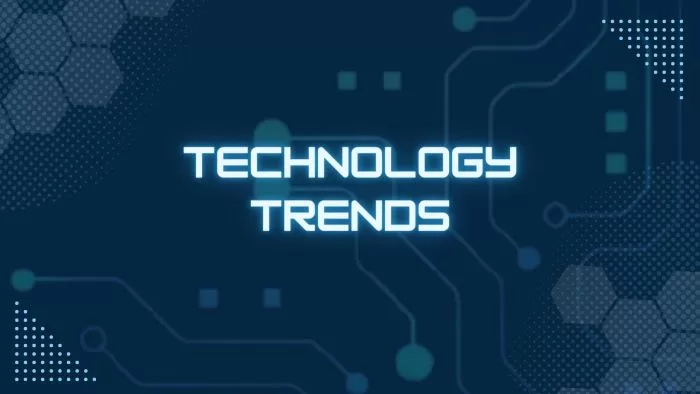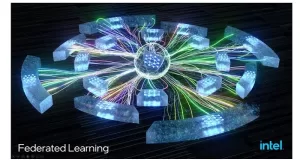9 Important Tech Trends to Keep an Eye on in 2024

Staying abreast of Tech Trends in 2024 is essential for businesses and individuals who want to remain relevant in today’s rapidly transforming digital landscape. By understanding tech trends, enterprises can identify new opportunities, boost efficiency levels, and better serve their customers’ needs. On the other hand, staying informed about tech advances helps individuals with career development opportunities as well as remaining competitive in the job market.
Here is a brief summary of some of the top technology trends expected to make an impact in 2023:
1. Artificial Intelligence (AI) and Machine Learning (ML)
In 2023, Artificial Intelligence (AI) and Machine Learning (ML) are expected to continue their rapid growth and evolution, potentially revolutionizing various industries. AI and Machine Learning technologies will continue to advance, making them capable of performing complex tasks more precisely and efficiently. AI and ML integration into applications such as virtual assistants, chatbots, autonomous vehicles, and robotics is becoming more widespread, leading to increased productivity and cost savings across healthcare, finance, and manufacturing sectors. However, ethical and regulatory implications associated with these technologies must also be carefully considered – requiring careful oversight to guarantee they are developed responsibly for beneficial purposes.
2. Augmented Reality (AR) and Virtual Reality (VR)
Augmented Reality (AR) and Virtual Reality (VR) are immersive technologies that enable users to interact with digital content and environments in new and innovative ways.
Augmented Reality (AR) is a technology that projects digital information onto the physical world, enabling users to experience virtual objects in real-world settings. AR can be experienced through smartphones, tablets, or dedicated AR devices like smart glasses.
Virtual Reality (VR) creates fully immersive digital environments replicating a user’s physical presence in a fictitious world. VR is experienced through special headsets that block out the physical world and replace it with an entirely virtual one, offering a more captivating experience than traditional screens can provide.
AR and VR have many applications in entertainment, education, training, and marketing. Entertainment uses AR/VR in gaming, filmmaking, live events to create more captivating and interactive experiences for audiences. Education and training use them to simulate real-world scenarios and provide hands-on learning opportunities. Finally, marketing uses AR and VR to create more immersive advertising campaigns.
Advances in hardware, software, and connectivity have driven the development and adoption of AR and VR. As these technologies continue to evolve and become more accessible, they have the potential to transform how we interact with the world around us, creating new opportunities for learning, entertainment, and productivity.
3. Blockchain technology
Blockchain technology is a decentralized, distributed ledger that records transactions on a network of computers. Each transaction on the blockchain is recorded as a block, and these blocks are linked together in a chain. Once a block is added to the chain, it cannot be altered or deleted, providing a secure and transparent record of all transactions.
Blockchain technology was initially created as the backbone for cryptocurrencies such as Bitcoin, but its applications go far beyond finance. Blockchain can store and distribute a range of data – such as financial transactions, digital identities and voting records – without needing a central authority to validate transactions. By eliminating this need for central validation of transactions, blockchain reduces costs, boosts efficiency and enhances transparency and security across various industries.
One of the key features of blockchain technology is its decentralized network. The network is maintained by a decentralized community rather than any single authority, making it highly resistant to manipulation or data compromise. Furthermore, blockchain allows smart contracts – self-executing agreements written directly into code – which automate contract execution and eliminate the need for intermediaries.
While blockchain technology has the potential to transform various industries, challenges still need to be addressed, such as scalability, regulatory issues, and interoperability. However, the continued development and adoption of blockchain technology have the potential to revolutionize the way we store and share data, conduct transactions, and interact with each other.
4. The Internet of Things (IoT)
The Internet of Things (IoT) refers to the network of physical devices, vehicles, appliances, and other objects embedded with sensors, software, and connectivity, allowing them to collect and exchange data. The data collected by these devices can be analyzed to provide insights and improve efficiency in a wide range of industries, such as healthcare, transportation, and manufacturing.
IoT devices can range from simple sensors to complex systems like self-driving cars or smart homes. These devices communicate with each other and centralized systems to collect and process data in real-time. For example, a smart thermostat in a home can collect data on the temperature and humidity and adjust the settings accordingly to optimize energy efficiency.
The potential applications of IoT are vast and include remote monitoring of equipment, predictive maintenance, and even the development of smart cities. However, as the number of IoT devices grows, there are concerns about data privacy and security and the potential for cyberattacks. To address these concerns, companies are developing new security protocols and working with regulatory bodies to establish industry standards.
As the cost of IoT devices continues to decrease and the technology becomes more accessible, it can transform how we interact with our environments and create new opportunities for businesses to improve efficiency and productivity.
5. Cybersecurity
Cybersecurity is an essential component of the technology landscape, and it is expected to remain a critical area of focus in 2023 and beyond. With the growing number of connected devices and the increasing sophistication of cyber threats, cybersecurity has become a top priority for businesses, governments, and individuals.
The need for cybersecurity has been driven by the growing prevalence of cyberattacks, which can take various forms, such as phishing attacks, malware, ransomware, and denial-of-service attacks. These attacks can cause significant financial losses and damage a company’s reputation, making cybersecurity a critical area of investment for businesses of all sizes.
In response to the growing threat of cyberattacks, businesses are adopting new cybersecurity measures, such as multi-factor authentication, encryption, and advanced threat detection systems. Governments are also developing new regulations to ensure the privacy and security of digital information. For example, the European Union’s General Data Protection Regulation (GDPR) requires companies to protect personal data and notify users during a data breach.
In addition to traditional cybersecurity measures, emerging technologies such as artificial intelligence and machine learning are being used to detect and prevent cyber threats. These technologies can analyze large volumes of data to identify patterns and anomalies that may indicate a potential security breach.
As the technology landscape continues to evolve, cybersecurity will remain a critical investment area for businesses and governments alike. By developing and implementing effective cybersecurity measures, organizations can protect themselves against cyber threats and ensure the privacy and security of their digital assets.
6. Edge Computing
Edge computing is a distributed computing paradigm in which data processing and storage are performed closer to the network’s edge, where the data is generated, rather than sending all data to a central location or the cloud for processing. This enables faster processing and response times and can be particularly useful for time-sensitive applications, such as real-time analytics, automation, and autonomous vehicles.
In edge computing, the data is processed by small, local data centers or servers located closer to the devices generating the data. This reduces latency, the time it takes for data to travel from the device to the central processing unit and back to the device. Edge computing can also reduce the amount of data that needs to be transmitted to the cloud, lowering network bandwidth requirements and improving network efficiency.
Edge computing can be used in a wide range of applications, such as industrial automation, healthcare, smart cities, and the Internet of Things. For example, in a manufacturing facility, edge computing can process data from sensors in real time, optimizing production processes and reducing downtime.
The trend toward edge computing is driven by the growth of connected devices and the need for faster and more efficient data processing. As the number of connected devices grows, edge computing is expected to become increasingly important, enabling faster processing and more efficient use of network resources.
7. Quantum computing
Quantum computing is an emerging technology expected to make significant progress in 2023 and beyond. While still in its early stages, quantum computing has the potential to revolutionize computing by solving complex problems that are currently beyond the capabilities of classical computers.
In 2023, researchers and developers are expected to make progress in developing practical quantum computing systems that can be used for real-world applications. Several companies, including IBM, Google, and Microsoft, are already developing quantum computers and quantum computing software.
One of the key areas where quantum computing is expected to make an impact is in cryptography, where it can be used to break complex encryption algorithms currently considered unbreakable by classical computers. Quantum computing can also be used to simulate complex systems, such as chemical reactions and molecular dynamics, which can lead to the development of new materials and drugs.
In addition to these applications, quantum computing can be used for optimization problems, such as supply chain management, logistics, and financial portfolio management. Quantum computing can also be used for machine learning, accelerating the training of deep neural networks and leading to more accurate predictions and faster processing times.
While quantum computing is still in its early stages, it has the potential to transform computing and solve some of the most complex problems in the world. As the technology continues to evolve, it is expected to become more accessible and practical, leading to new applications and advancements in various industries.
8. Cloud computing
Cloud computing is a model of delivering computing resources, including servers, storage, databases, software, and other services, over the internet. Instead of managing and maintaining their computing infrastructure, organizations can access computing resources on-demand and pay for only what they use.
In 2023, cloud computing is expected to grow in popularity as more organizations adopt cloud-based services. The benefits of cloud computing, including scalability, cost savings, and increased efficiency, are driving this growth. With cloud computing, organizations can easily scale up or down their computing resources based on their needs without investing in their infrastructure.
In addition to traditional cloud computing services, such as Infrastructure as a Service (IaaS), Platform as a Service (PaaS), and Software as a Service (SaaS), new cloud services are also emerging, including Function as a Service (FaaS) and Containers as a Service (CaaS). These services enable organizations to take advantage of serverless computing and containerization, respectively, further increasing the efficiency and flexibility of cloud computing.
One trend expected to gain momentum in 2023 is the use of hybrid cloud computing, which combines public and private cloud services. Hybrid cloud computing enables organizations to take advantage of the benefits of both public and private clouds, such as cost savings and increased security.
As cloud computing continues to evolve, it is expected to become even more advanced, with new services and technologies being developed. With the growth of cloud computing, it is essential for organizations to ensure the security and privacy of their data, as well as to manage their costs and ensure compliance with regulations carefully.
9. 5G Technology
5G technology is the next generation of wireless communication technology that promises faster speeds, lower latency, and increased network capacity compared to 4G technology. In 2023, 5G technology is expected to grow and expand, leading to new applications and use cases.
One of the main benefits of 5G technology is its ability to support the Internet of Things (IoT). With 5G, it is possible to connect more devices to the internet and transmit data faster, making it possible to develop new IoT applications, such as smart cities, autonomous vehicles, and remote healthcare.
In addition to IoT, 5G technology is also expected to impact the entertainment industry, with the potential to enable immersive virtual and augmented reality experiences. With faster speeds and lower latency, 5G can deliver high-quality streaming video and support new types of interactive content, such as real-time multiplayer gaming.
Another area where 5G technology is expected to impact is in the enterprise space, where it can be used for applications such as remote work and collaboration, edge computing, and industrial automation. With its high speed and low latency, 5G can enable new levels of automation and machine-to-machine communication, leading to increased efficiency and productivity.
However, the rollout of 5G technology also poses challenges, such as the need for significant infrastructure investments and the potential for cybersecurity risks. As 5G technology continues to evolve, it is essential for organizations to carefully consider these challenges and take steps to ensure the security and reliability of their networks and applications.
















